CIU National President Mark Weber sent the following memorandum to the CIU National Board of Directors on July 20, 2023, on behalf of the National Executive.
Members of the National Board of Directors,
The question of Branch membership allocation was recently brought to the attention of the CIU National Executive, in the context of members who physically work in a given geographical area under the jurisdiction of one Branch, but who report to an office located in a different geographical area under the jurisdiction of another Branch. After careful consideration of the matter, the CIU National Executive would like to offer the following additional guidance to clarify existing allocation rules.
The National Executive found that the question of Branch membership allocation mainly revolves around CIU Branch Rule 5.3 and CIU By-Law 7.5(2), which state:
- Branch Rule 5.3 “As a general rule, the membership allocation shall be where the member physically In cases where the membership allocation is in question, the CIU National Executive shall decide where the member will be allocated in the best interest of the organization.”
- By-Law 5(2) “[…] the CIU National Office shall remit to the Branch the dues portion accruing to the Branch based on calculation of members and Rands whose place of work is in the Branch’s jurisdiction.”
The question of where the work is performed, and therefore what constitutes the “place of work”, is central in allocating Branch membership. For most members, Branch allocation is straightforward, as they physically work in the same geographical area as the office they report to, often in the exact same location, and under the jurisdiction of the same union Branch.
However, where a member physically works in a given geographical area but reports to an office located in another geographical area, as per Branch Rule 5.3 the place of work must be considered to be where the member physically performs work, and not where they report to. In this case, the member should be allocated to the union Branch which has jurisdiction over the geographical area of the member’s physical place of work, both for representation and remittance of union dues.
This principle applies no matter the work arrangement. The determining factor in membership allocation is the physical location where work is being performed, not the location of the CBSA office/manager the member reports to. In cases where a member has a telework or hybrid work arrangement, Branch membership allocation is determined based on where the member physically works. If the member works from a CBSA office some of the time, the Branch representing that CBSA office is the branch that member belongs to. If the member works from home 100% of the time, the branch representing the nearest CBSA office where the member would report to is the branch that member belongs to. On the rare occasion where a member who works from home lives in an area serviced by one Branch, and the nearest physical CBSA office where the member would be expected to come into work is serviced by a different Branch, membership allocation will be based on the location of the CBSA office/satellite office.
Example
Under a telework arrangement, Bill lives in Southern British Columbia but reports to a CBSA office located in Toronto. Twice a week, Bill has to go to a physical CBSA workplace to perform some of his work. He does so at the nearest CBSA office, also located in Southern BC. Even though Bill ultimately reports to an office located in Toronto, he is a member of the Branch which has jurisdiction over the area where the work is being physically performed. In this case, this would be the CIU BC Southern Branch, and not the CIU Toronto Branch, as Bill lives and works in Southern British Columbia.
Past interpretation
It is important to note that the above is not a novel interpretation and echoes the principles set in a 2005 decision by then CEUDA National President Ron Moran.
Assignments and secondments
Members who are on assignment or on secondment for more than six months should be allocated to the CIU Branch servicing the location of the assignment or secondment, according to the same principles outlined above. In order to simplify the allocation process and to avoid unnecessary complications, Branch membership re-allocation will not be required for assignments or secondments under six months.
Other considerations
It is worth noting that the importance of assigning a member to the Branch servicing the area where a member physically works is not purely academic and has tangible, practical implications. From the point of view of union-related activities, it makes little sense for a member physically residing and working in City A to be allocated to a Branch whose jurisdiction is in City B, where both cities are hours apart, even if the member’s manager is in City B. The member residing in City A would attend rallies, picket lines and other union activities taking place in City A, overseen by the Branch whose jurisdiction is in City A. It is the Branch whose jurisdiction is in City A that would help the member should they require assistance. In the event of a strike, it is the same Branch that would pay their strike pay top-up. Why then should they be a member of another Branch, in City B or elsewhere?
Next steps
In light of the above, it is likely that Branch Presidents will want to review their local membership list. The CIU National Executive invites Branch Presidents to work together to ensure members are assigned to the proper Branch, based on the principles outlined previously. Any necessary change should be communicated to membership@ciu-sdi.ca. Should you have any questions, please contact the National Vice-President assigned to your Branch.
In solidarity, and on behalf the CIU National Executive,
Mark Weber
National President
PDF version of documents:








